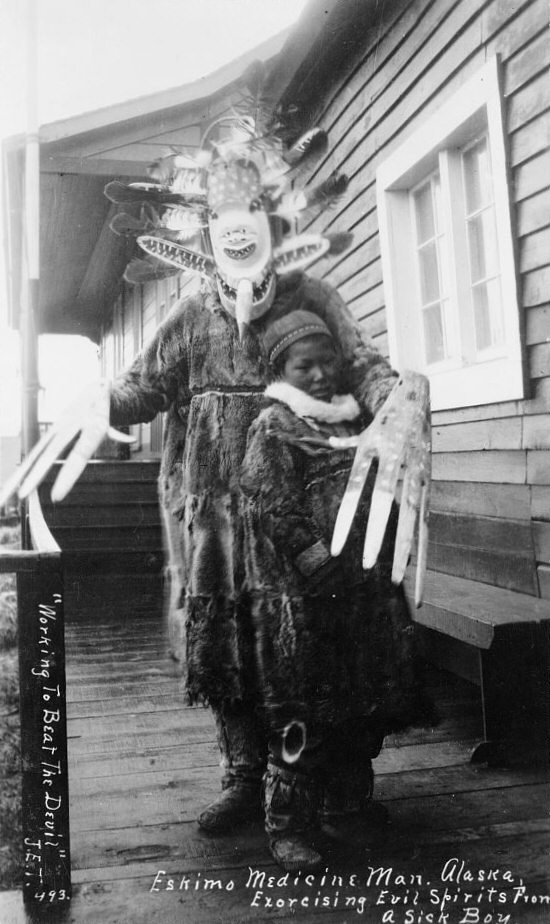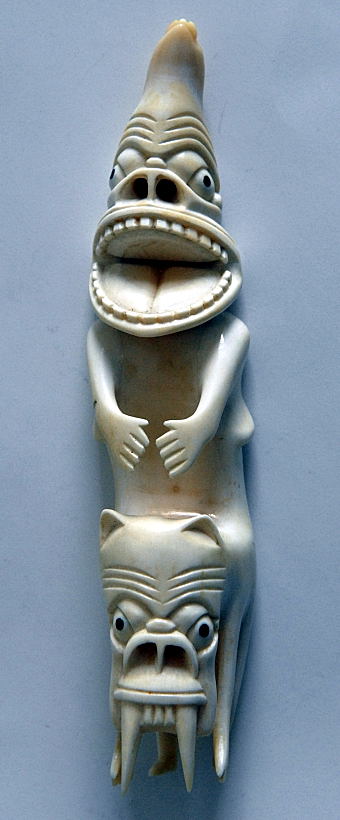|
Alaska Native Religion
Traditional Alaskan Native religion involves mediation between people and spirits, souls, and other immortal beings. Such beliefs and practices were once widespread among Inuit (including Iñupiat), Yupik, Aleut, and Northwest Coastal Indian cultures, but today are less common. Merkur 1985: 4 They were already in decline among many groups when the first major ethnological research was done. For example, at the end of the 19th century, Sagdloq, the last medicine man among what were then called in English, "Polar Eskimos", died; he was believed to be able to travel to the sky and under the sea, and was also known for using ventriloquism and sleight-of-hand. Merkur 1985:134 The term "Eskimo" has fallen out of favour in Canada and Greenland, where it is considered pejorative and "Inuit" is used instead. However, "Eskimo" is still considered acceptable among some Alaska Natives of Yupik and Inupiaq (Inuit) heritage and is at times preferred over "Inuit" as a collective reference. Th ... [...More Info...] [...Related Items...] OR: [Wikipedia] [Google] [Baidu] |
Yupik Shaman Nushagak
Yupik may refer to: * Yupik peoples, a group of indigenous peoples of Alaska and the Russian Far East * Yupik languages, a group of Eskimo-Aleut languages Yupꞌik (with the apostrophe) may refer to: * Yup'ik people, a Yupik people from western and southwestern Alaska * Yup'ik language, their language ** Yup'ik syllabary The Yugtun or Alaska script is a syllabary invented around the year 1900 by Uyaquq to write the Central Alaskan Yup'ik language. Uyaquq, who was monolingual in Yup'ik but had a son who was literate in English, initially used indigenous pictogram ..., a writing system formerly used for the language {{disambig Language and nationality disambiguation pages ... [...More Info...] [...Related Items...] OR: [Wikipedia] [Google] [Baidu] |
Aleut Language
Aleut () or ''Unangam Tunuu'' is the language spoken by the Aleut living in the Aleutian Islands, Pribilof Islands, Commander Islands, and the Alaska Peninsula (in Aleut , the origin of the state name Alaska). Aleut is the sole language in the Aleut branch of the Eskimo–Aleut language family. The Aleut language consists of three dialects, including (Eastern Aleut), / (Atka Aleut), and / (Western Aleut; now extinct). Various sources estimate there are fewer than 100 to 150 remaining active Aleut speakers. Eastern and Atkan Aleut are classified as "critically endangered and extinct" and have aEGIDSrating of 7. The task of revitalizing Aleut has largely been left to local government and community organizations. The overwhelming majority of schools in the historically Aleut-speaking regions lack any language/culture courses in their curriculum, and those that do fail to produce fluent or even proficient speakers. History The Eskimo and Aleut peoples were part of a migration f ... [...More Info...] [...Related Items...] OR: [Wikipedia] [Google] [Baidu] |
Restless Ghost
In mythology and folklore, a vengeful ghost or vengeful spirit is said to be the spirit of a dead person who returns from the afterlife to seek revenge for a cruel, unnatural or unjust death. In certain cultures where funeral and burial or cremation ceremonies are important, such vengeful spirits may also be considered as unhappy ghosts of individuals who have not been given a proper funeral. Cultural background The concept of a vengeful ghost seeking retribution for harm that it endured as a living person goes back to ancient times and is part of many cultures. According to such legends and beliefs, they roam the world of the living as restless spirits, seeking to have their grievances redressed, and may not be satisfied until they have succeeded in punishing either their murderers or their tormentors. In certain cultures vengeful ghosts are mostly female, said to be women that were unjustly treated during their lifetime. Such women or girls may have died in despair or the suff ... [...More Info...] [...Related Items...] OR: [Wikipedia] [Google] [Baidu] |
Tupilaq
In Greenlandic Inuit religion, a (, , or in Inuktitut syllabics) was an avenging monster fabricated by a practitioner of witchcraft or shamanism by using various objects such as animal parts (bone, skin, hair, sinew, etc.) and even parts taken from the corpses of children. The creature was given life by ritualistic chants. It was then placed into the sea to seek and destroy a specific enemy. The use of a was considered risky, as if it was sent to destroy someone who had greater magical powers than the one who had formed it, it could be sent back to kill its maker instead,Kleivan & Sonne 1985: 23; Plate XLIII, XLV although the maker of the could escape by public confession of their deed. Because were made in secret, in isolated places and from perishable materials, none have been preserved. Early European visitors to Greenland, fascinated by the native legend, were eager to see what looked like, so the Inuit began to carve representations of them out of sperm whale teeth. ... [...More Info...] [...Related Items...] OR: [Wikipedia] [Google] [Baidu] |
Soul
In many religious and philosophical traditions, there is a belief that a soul is "the immaterial aspect or essence of a human being". Etymology The Modern English noun ''soul'' is derived from Old English ''sāwol, sāwel''. The earliest attestations reported in the ''Oxford English Dictionary'' are from the 8th century. In King Alfred's translation of ''De Consolatione Philosophiae'', it is used to refer to the immaterial, spiritual, or thinking aspect of a person, as contrasted with the person's physical body; in the Vespasian Psalter 77.50, it means "life" or "animate existence". The Old English word is cognate with other historical Germanic terms for the same idea, including Old Frisian ''sēle, sēl'' (which could also mean "salvation", or "solemn oath"), Gothic ''saiwala'', Old High German ''sēula, sēla'', Old Saxon ''sēola'', and Old Norse ''sāla''. Present-day cognates include Dutch ''ziel'' and German ''Seele''. Religious views In Judaism and in some Christian d ... [...More Info...] [...Related Items...] OR: [Wikipedia] [Google] [Baidu] |
Soul Dualism
Soul dualism, also called dualistic pluralism or multiple souls, is a range of beliefs that a person has two or more kinds of souls. In many cases, one of the souls is associated with body functions ("body soul") and the other one can leave the body ("free soul" or "wandering soul"). Sometimes the plethora of soul types can be even more complex. Sometimes, a shaman's "free soul" may be held to be able to undertake a spirit journey. Examples Austronesia The belief in soul dualism found throughout most Austronesian shamanistic traditions. The reconstructed Proto-Austronesian word for the "body soul" is ''*nawa'' ("breath", "life", or "vital spirit"). It is located somewhere in the abdominal cavity, often in the liver or the heart (Proto-Austronesian ''*qaCay''). The "free soul" is located in the head. Its names are usually derived from Proto-Austronesian ''*qaNiCu'' ("ghost", "spirit f the dead), which also apply to other non-human nature spirits. The "free soul" is also referred ... [...More Info...] [...Related Items...] OR: [Wikipedia] [Google] [Baidu] |
Tungusic Languages
The Tungusic languages (also known as Manchu-Tungus and Tungus) form a language family spoken in Eastern Siberia and Manchuria by Tungusic peoples. Many Tungusic languages are endangered. There are approximately 75,000 native speakers of the dozen living languages of the Tungusic language family. Some linguists consider Tungusic to be part of the controversial Altaic language family, along with Turkic, Mongolic, and sometimes Koreanic and Japonic. The term "Tungusic" is from an exonym for the Evenk people (Ewenki) used by the Yakuts ("tongus"). It was borrowed into Russian as "тунгус", and ultimately transliterated into English as "Tungus". Classification Linguists working on Tungusic have proposed a number of different classifications based on different criteria, including morphological, lexical, and phonological characteristics. Some scholars have criticized the tree-based model of Tungusic classification, arguing the long history of contact among the Tungusic langua ... [...More Info...] [...Related Items...] OR: [Wikipedia] [Google] [Baidu] |
Siberian Yupik
Siberian Yupiks, or Yuits (russian: Юиты), are a Yupik peoples, Yupik people who reside along the coast of the Chukchi Peninsula in the far Russian Far East, northeast of the Russia, Russian Federation and on St. Lawrence Island in Alaska. They speak Siberian Yupik language, Central Siberian Yupik (also known as Yuit), a Yupik language of the Eskimo–Aleut family of languages. They are also known as Siberian or Eskimo (russian: эскимосы). The name Yuit (юит, plural: юиты) was officially assigned to them in 1931, at the brief time of the campaign of support of indigenous cultures in the Soviet Union. Their self-designation is Yupighyt (йупигыт) meaning "true people". Sirenik Eskimos also live in that area, but their extinct language, Sireniki Eskimo language, Sireniki Eskimo, shows many peculiarities among Eskimo languages and is mutually unintelligible with the neighboring Siberian Yupik languages. [...More Info...] [...Related Items...] OR: [Wikipedia] [Google] [Baidu] |
Angakkuq
The Inuit angakkuq (plural: ''angakkuit'', Inuktitut syllabics ᐊᖓᑦᑯᖅ or ᐊᖓᒃᑯᖅ; Inuvialuktun: '; kl, angakkoq, pl. ''angakkut'') is an intellectual and spiritual figure in Inuit culture who corresponds to a medicine man. Other cultures, including Alaska Natives, have traditionally had similar spiritual mediators, although the Alaska Native religion has many forms and variants. Role in Inuit society Both women, such as Uvavnuk, and men could become an angakkuq, although it was rarer for women to do so. The process for becoming an angakkuq varied widely. The son of a current angakkuq might be trained by his father to become one as well. A shaman might make a prophecy that a particular infant would become a prophet in adulthood. Alternatively, a young man or woman who exhibited a predilection or power that made them stand out might be trained by an experienced mentor. There are also instances of angakkuit claiming to have been called to the role through dreams o ... [...More Info...] [...Related Items...] OR: [Wikipedia] [Google] [Baidu] |
Aua (angakkuq)
Aua (also transcribed Awa and Ava) (circa 1870, Igloolik area - after 1922) was an Inuk '' angakkuq'' (medicine man) known for his anthropological input to Greenland anthropologist Knud Rasmussen. As a spiritual healer practicing into the 1920s, Aua provided perspective on Inuit mythology at a time when it was being subsumed by the introduction of Christianity. Aua told the story of his cousin's mother Uvavnuk, whose song "The Great Earth" is still popular. Aua was married to Orulo and they had four children. His encounters with the Danish explorer were fictionalised in the 2006 film ''The Journals of Knud Rasmussen ''The Journals of Knud Rasmussen'' is a 2006 Canadian-Danish film directed by Zacharias Kunuk and Norman Cohn. The film is about the pressures on traditional Inuit shamanistic beliefs as documented by Knud Rasmussen during his travels across the C ...'', by the Inuit team who had produced '' Atanarjuat: The Fast Runner''. Sources * Penny Petrone. ''Northern Voic ... [...More Info...] [...Related Items...] OR: [Wikipedia] [Google] [Baidu] |







